Following the Artemis III mission, which lands the first humans near the lunar south pole, Artemis IV astronauts will live and work on humanity’s first lunar space station, Gateway, opening up new opportunities for science and preparation for human missions to Mars . The mission will combine the complex choreography of multiple launches and dockings of spacecraft in lunar orbit, and will also mark the debut of a larger, more powerful version of NASA’s SLS (Space Launch System) rocket and a new mobile launcher.
Private lunar lander will deliver a “memory disk” containing 275 human languages to the Moon in 2024
Ispace will send a time capsule containing 275 human languages to the moon as part of its lunar mission later this year. A Japanese lunar exploration company that is working to increase human presence in space has teamed up with the United Nations Educational, Scientific and Cultural Organization (UNESCO) to take an important part of our humanity and keep it on the Moon during the upcoming Hakuto-R Mission 2, which will send an automatic lander to the surface of the Moon.
The mission will be to deliver a UNESCO-developed “memory disk” containing 275 languages and other cultural artifacts to the lunar surface. This will be an attempt to preserve the lives of part of humanity in case there is ever a threat to the existence of humanity on Earth.
These languages will form part of the preamble of the UNESCO Constitution, which emphasizes “the importance of preserving world unity, linguistic diversity and cultures.” Ispace will place the memory drive on board its Resilience lunar lander, part of the Hakuto-R 2 mission, and send it to the Moon sometime in late 2024 if current timelines continue.
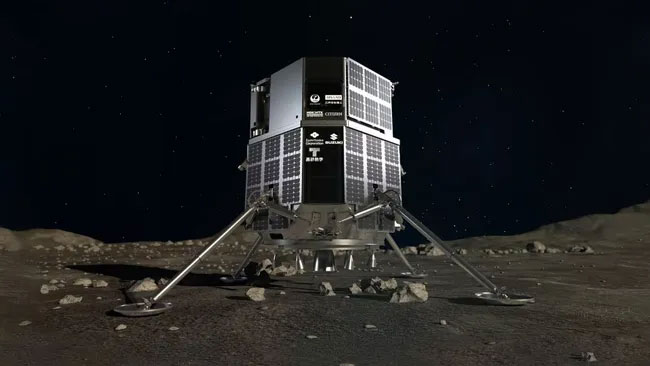
Artist’s impression of the ispace Hakuto-R lunar spacecraft on the Moon. ISpace
“Maintaining linguistic diversity and preserving culture are important aspects of UNESCO’s mandate. We are honored to announce that Ispace’s Hakuto-R Mission 2 will contribute to UNESCO’s lunar mission for the benefit of the world,” said Julien Lamami, CEO of ispace-Europe in a statement.
“We are moving forward with the Hakuto-R 2 mission, thanks to recent advances in lander and rover development that have put us on track for a launch in winter 2024 with a UNESCO payload,” Lamami continued.
Ispace’s first lunar lander, Hakuto-R, launched on the company’s Mission 1 in December 2022. When the lander made its historic landing attempt on April 25, 2023, its onboard computer miscalculated the altitude measurement, causing the spacecraft to crash.
The company’s second mission, Hakuto-R Mission 2, is scheduled to launch sometime in the winter of 2024 and will include a microlunar rover.
ispace is already developing its Mission 3, which is scheduled to launch in 2026 and will include a NASA-built science payload that will be included in the agency’s Commercial Lunar Payload Services (CLPS) program. This mission will send the Apex 1.0 lunar lander, a larger spacecraft with a projected payload of 1,100 pounds (500 kg), to the Moon.
Humanity’s first space station to orbit the Moon
NASA will launch HALO (Accommodation and Logistics Outpost), the center of the image in the background, along with the power and propulsion element (not pictured) into lunar orbit ahead of the Artemis IV mission as the first elements of Gateway, the first space station. During this mission, astronauts will launch the Orion spacecraft carrying the lunar I-Hab, parts of which are shown here in the foreground, and fly it to the Gateway. Lunar I-Hab is provided by ESA (European Space Agency) with significant hardware contribution from JAXA (Japan Aerospace Exploration Agency) and is one of four Gateway modules where astronauts will live and work in lunar orbit.
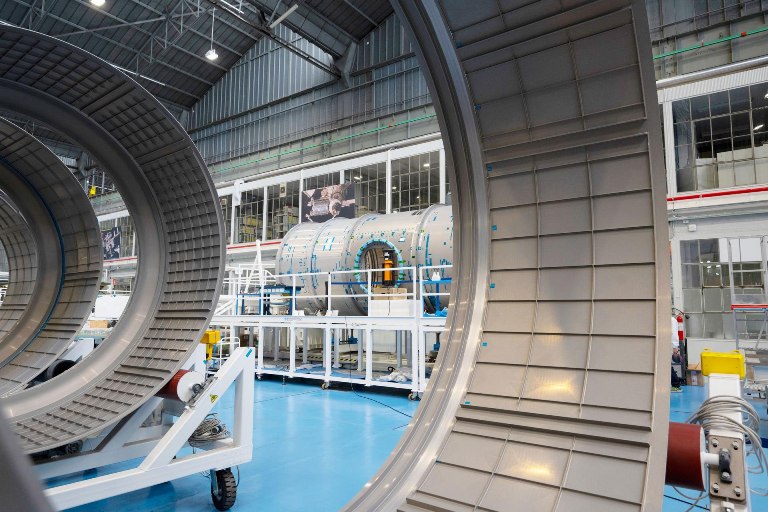
Gateway’s Lunar I-Hab and HALO modules are being built at the Thales Alenia Space industrial plant in Turin, Italy. ESA/Stefan Korvaja
Thales Alenia Space completed major welding work on HALO last year and began initial fabrication of the Lunar I-Hab. The company is a subcontractor to Northrop Grumman on the HALO project and a prime contractor to ESA on the Lunar I-Hab project.
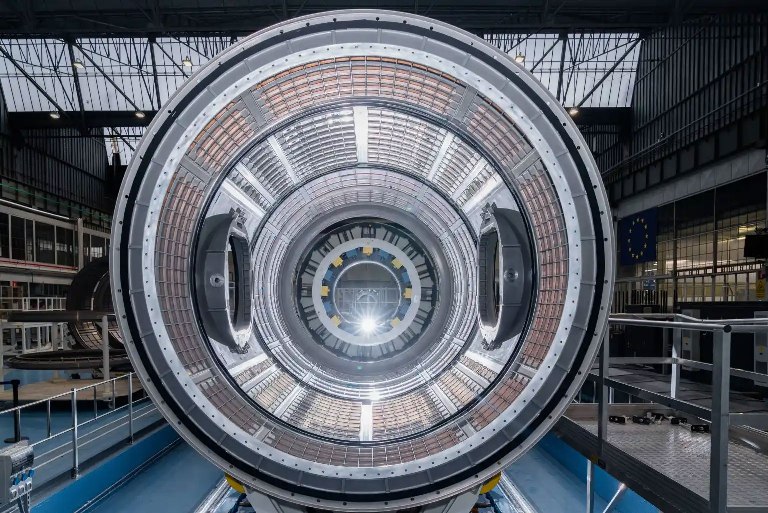
Northrop Grumman/Thales Alenia Space
Along with HALO, the Lunar I-Hab and the power and propulsion element, two additional Gateway modules provided by ESA and the Mohammed Bin Rashid Space Center form the core components of the space station. CSA (Canadian Space Agency) provides the advanced external robotic system Canadarm3 and accessories for scientific instruments.
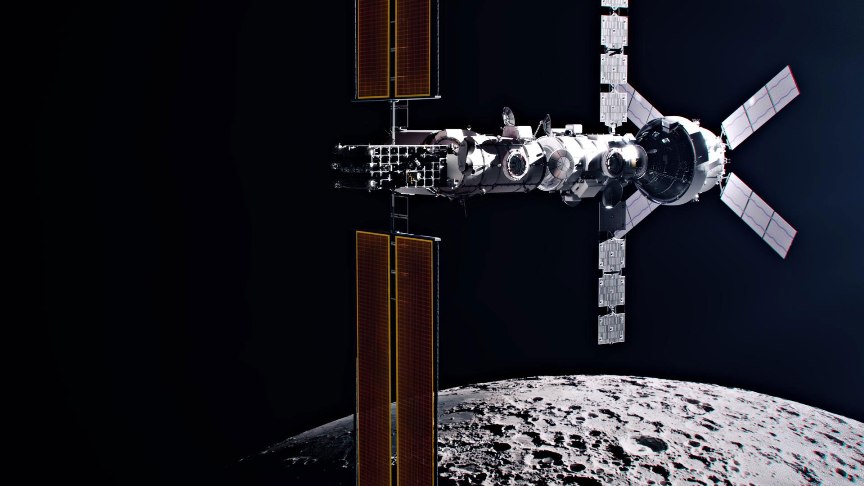
The Gateway space station, in polar orbit around the moon, is home to the Orion spacecraft and SpaceX’s deep space logistics spacecraft supporting scientific discovery on the lunar surface during the Artemis IV mission.
International teams of astronauts living, conducting scientific research and preparing for missions to the South Pole region of the Moon with Gateway will become the first humans to inhabit deep space.
Artemis missions accelerate scientific exploration on the lunar surface and soon into lunar orbit aboard the Gateway. Built through international and commercial partnerships, the Gateway will include docking ports for a variety of visiting spacecraft, space for crews to live, work and train for missions to the lunar surface, and research tools for heliophysics, human health and life sciences.
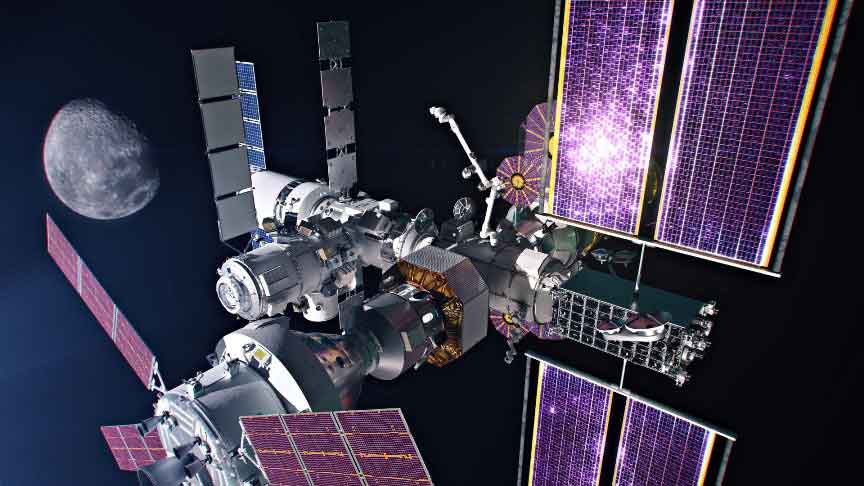
Artist’s concept of a complete gateway configuration. NASA
Gateway’s oval orbit passes over the Moon’s North and South Pole regions and provides unprecedented opportunities for science and access to the lunar surface. The orbit combines the benefits of surface access from low lunar orbit with the fuel efficiency of distant retrograde orbit, while offering unique views of the Earth, Moon, Sun and deep space for scientific exploration.
The Gateway is taking shape on the ground, and engineers will connect its first two modules—the power and propulsion element (PPE), built by Maxar, and the habitation and logistics element (HALO), built by Northrop Grumman—for launch aboard the SpaceX Falcon Heavy. The elements will spend about a year traveling in lunar orbit, using highly efficient solar-electric propulsion and the gravity of the Earth, Moon and Sun to reach their destination. A variety of science instruments on HALO and in PPE will provide science data on radiation during the transit and while Gateway is in lunar orbit.
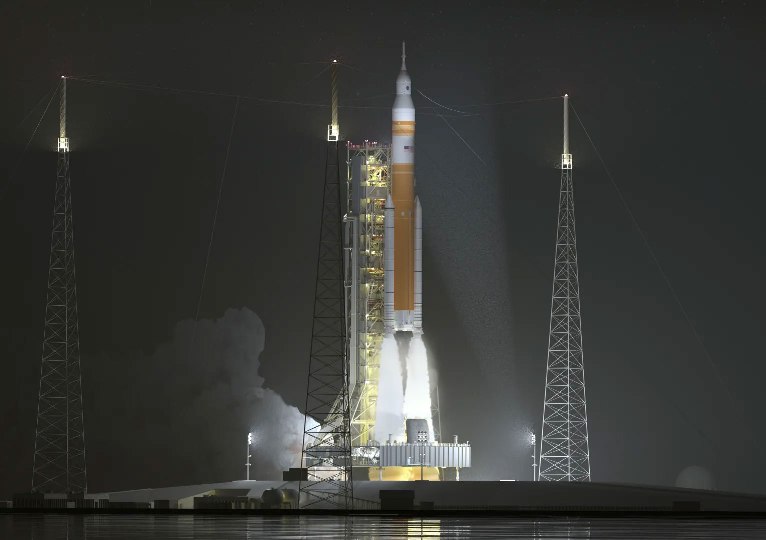
Artist’s concept of the crew configuration of NASA’s Space Launch System (SLS) Block 1B rocket during liftoff from the new mobile launcher for night launch. NASA
Once in orbit around the Moon, Gateway computers will go through a checklist of elements to prepare for the arrival of Artemis IV’s second crew housing element, the International Habitat Module, or I-Hab, provided by ESA (European Space Agency). The I-Hab will expand the space where Gateway astronauts will live, work, conduct innovative scientific research and prepare for their missions to the lunar surface. I-Hab also includes critical life support systems provided by JAXA (Japan Space Agency), allowing for longer stays on board the Gateway.
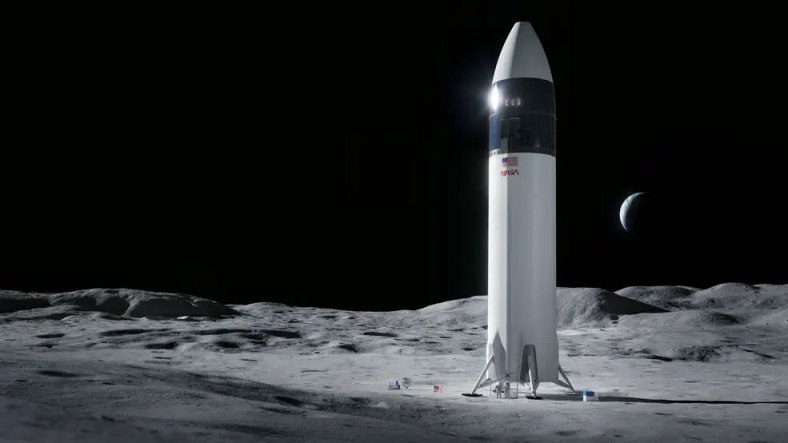
Artist’s concept of the SpaceX Starship human landing system. SpaceX
Before launching the crew and I-Hab on the SLS rocket, NASA and its partners will pre-position two additional spacecraft for the mission: SpaceX’s Starship Human Landing System, which will carry the next generation of spacesuits for lunar walks, and SpaceX’s Dragon XL, a logistics module. carrying scientific experiments and other materials for the mission. The upgraded starship will support Artemis IV with enhanced capabilities for long-term exploration and future missions, including docking with Gateway.
Flexible Levitation on Track (FLOAT) on a Lunar Rail System
NASA’s Jet Propulsion Laboratory wants to build the first lunar rail system that will transport payload to the Moon reliably, autonomously and efficiently. A reliable and durable robotic transportation system will be critical to the day-to-day operations of a sustainable lunar base in the 2030s, as envisioned in NASA’s Moon-Mars plan and mission concepts such as Robotic Lunar Surface Operations 2 (RLSO2).
The FLOAT system uses motorless magnetic robots that float over a three-layer flexible film guide: a graphite layer allows the robots to passively float over the guides using diamagnetic levitation, a flexible circuit layer generates electromagnetic thrust for controlled movement of the robots along the guides, and an additional thin-film solar panel layer generates energy for the base in sunlight. FLOAT robots have no moving parts and hover above a track to minimize abrasion/wear by lunar dust, unlike lunar robots with wheels, legs or tracks.
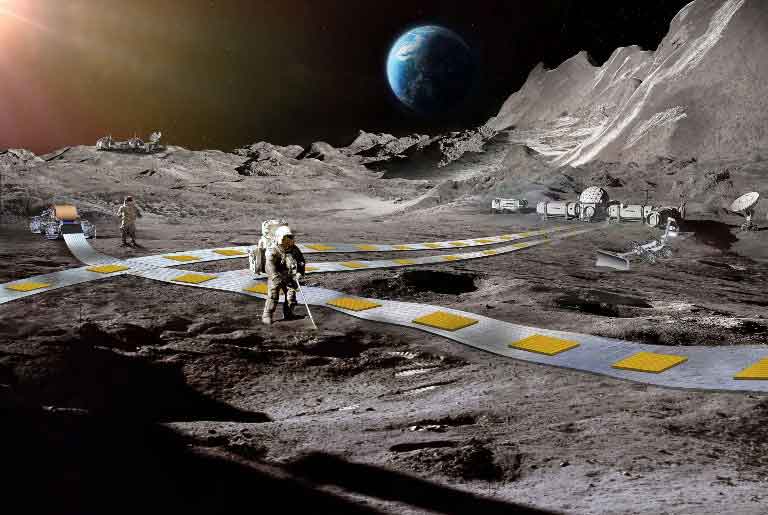
Artist’s concept of a new approach proposed by the 2024 NIAC Phase II awardee for possible future missions, depicting the lunar surface with planet Earth on the horizon. Ethan Shaler
FLOAT’s tracks unfold directly on the lunar regolith, avoiding major on-site construction – unlike conventional roads, railways or cable cars. Selected FLOAT robots will be able to transport payloads of various shapes/sizes (>30 kg/m^2) at useful speeds (>0.5 m/s). FLOAT will operate autonomously in a dusty, inhospitable lunar environment with minimal site preparation, and its track network can be deployed/reconfigured over time to meet changing lunar base mission requirements.
Startup Max Space – expandable habitable modules
Startup Max Space has big plans for its habitat technology, which will first test in space in 2026. The startup is developing a line of inflatable space habitats, the largest of which can provide the same internal volume as a sports stadium. These plans, which Max Space presented on April 9, 2024 at the 39th Space Symposium, are intended to help our species make the difficult jump from its home planet.
“The problem with space today is that there is not enough habitable space in space,” Max Space co-founder Aaron Kemmer said Tuesday. “Unless we make usable space in space much cheaper and much larger, humanity’s future in space will remain limited.”
Back in 2010, Kemmer co-founded the extraterrestrial manufacturing company Made In Space, which has sent several 3D printing devices to the International Space Station (ISS) over the years. (Made In Space was acquired by Redwire in 2020)
Expandable habitats, as the name suggests, are launched in a compressed form to fit inside rocket fairings, but grow significantly in size when deployed in space. Therefore, they offer much greater bang for your buck in terms of volume than traditional “tin can” module designs.
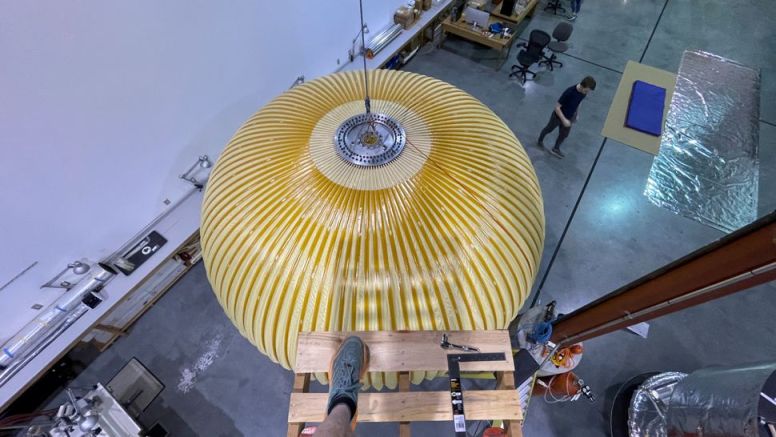
Max Space 20 cubic meters (706 cu ft) expandable habitat ground test facility. The flight version of this module is planned to be launched into low-Earth orbit in 2026. Max Space
For example, an expandable habitat with a sealed volume of 100 cubic meters (3,530 cubic feet) would be “at least an order of magnitude cheaper” than a comparable metal one, Kemmer said. (By comparison, the ISS offers 388 cubic meters, or 13,700 cubic feet, of habitable volume, not including the space provided by visiting vehicles.)
This is not a science fiction concept; three prototypes of the expandable module are currently orbiting the Earth. These are Genesis 1 and Genesis 2, free-flying vehicles launched in 2006 and 2007, respectively, and the Bigelow Expandable Activity Module (BEAM), which has been attached to the ISS since 2016.
All three were built by Nevada-based Bigelow Aerospace, which closed in 2020. The pressurized housings for Genesis 1 and Genesis 2 were designed and manufactured by Thin Red Line Aerospace, a small Canadian company run by Maxime de Jong. Another co-founder of Max Space.
The new startup, which has been operating for about a year, is commercializing Thin Red Line’s aerospace technology, according to Kemmer and de Jong. But this technology isn’t just an updated Genesis tread.
The new technology will conduct its first test beyond Earth in just two years if all goes according to plan: Max Space has booked a space for a joint SpaceX launch in 2026.
This mission will send a module the size of two large suitcases into orbit. However, this is a compressed habitat configuration. Once deployed, its pressurized volume will increase to 20 cubic meters (706 cu ft).
This deployment will set a new record for expandable habitats. Both Genesis prototypes have an internal volume of 11.5 cubic meters (406 cubic feet), while the BEAM has 16 cubic meters (565 cubic feet).
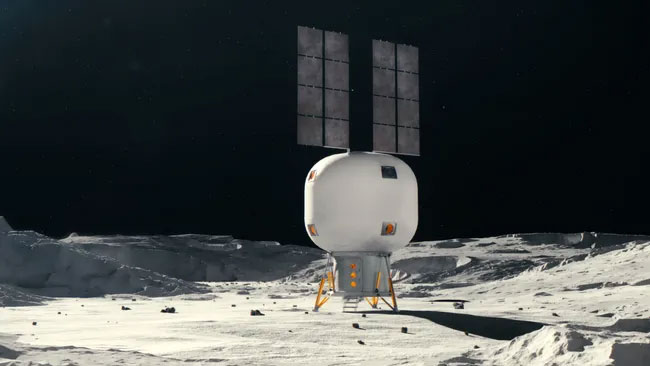
Artist’s illustration of Max Space’s expandable habitat on the Moon. Max Space
According to Kemmer, Max Space has already built a full-size prototype of the first flight vehicle, which the company is using for ground testing. The company has begun production of the aircraft, which will not be equipped with life support systems, but will have the same protection and durability as the human versions.
Max Space plans to continue to move quickly once this groundbreaking module enters orbit. The startup aims to launch its first 100 cubic meters (3,531 cubic feet) module in 2027 and create a 1,000 cubic meters (35,314 cubic feet) giant by 2030. After that, even larger variants could potentially be launched aboard SpaceX’s Starship, the company said.
The goal is to provide diverse destinations for a wide range of clients, from pharmaceutical companies that want to mass produce drugs in microgravity, to commercial space stations that want to expand their living space, to film studios that want to shoot movies in orbit.
But low-Earth orbit will only be the starting point for Max Space modules if everything goes according to plan.
“My dream is to build a city on the moon before I die,” Kemmer said. “So, the way I look at it is that it will be habitats, structures that will be placed in lava tubes buried beneath the lunar surface.”
The company’s modules will then go to Mars if all goes well, as Max Space wants to be a key driver of extraterrestrial settlement. Indeed, this is why Kemmer and de Jong founded the company – to help humanity expand its presence in the solar system.
NASA will land the first woman, the first person of color, its first international astronaut partner, and the first lunar instruments on the Moon
NASA has selected the first scientific instruments designed for astronauts to be deployed on the lunar surface during Artemis 3. Once installed near the lunar south pole, the three instruments will collect valuable scientific data about the lunar environment, the lunar interior and how to maintain a long-term human presence on the moon, which will help NASA prepare to send astronauts to Mars.
“Artemis heralds a bold new era of exploration in which the human presence enhances scientific discovery. With these innovative instruments placed on the lunar surface, we are embarking on a transformative journey that will empower human-machine collaboration—an entirely new way to do science,” said NASA Associate Administrator Pam Melroy. “These three deployed instruments have been selected to begin scientific research that will address key science challenges from the Moon to Mars.”
These instruments will address Artemis’ three scientific missions: understanding planetary processes, understanding the nature and origin of lunar polar volatiles, and exploring and mitigating the risks associated with exploration. They were chosen specifically because of their unique installation requirements for human use during lunar walks. All three payloads have been selected for further development to fly on Artemis III, scheduled to launch in 2026, although final mission decisions will be made at a later date. Members of these payload teams will become members of NASA’s Artemis III science team.
The Lunar Environment Monitoring Station (LEMS) is a compact, self-contained seismometric system designed to conduct continuous and long-term monitoring of the seismic environment, namely the movement of the earth from lunar earthquakes, in the south polar region of the Moon. The instrument will characterize the regional structure of the lunar crust and mantle, which will add valuable information for models of the formation and evolution of the Moon. LEMS previously received four years of NASA funding as part of the Lunar Instrument Development and Improvement Program for Engineering and Risk Mitigation. It is designed to operate on the lunar surface from three months to two years and can become a key station in the future global lunar geophysical network. LEMS is led by Dr. Mehdi Benna of the University of Maryland, Baltimore County.
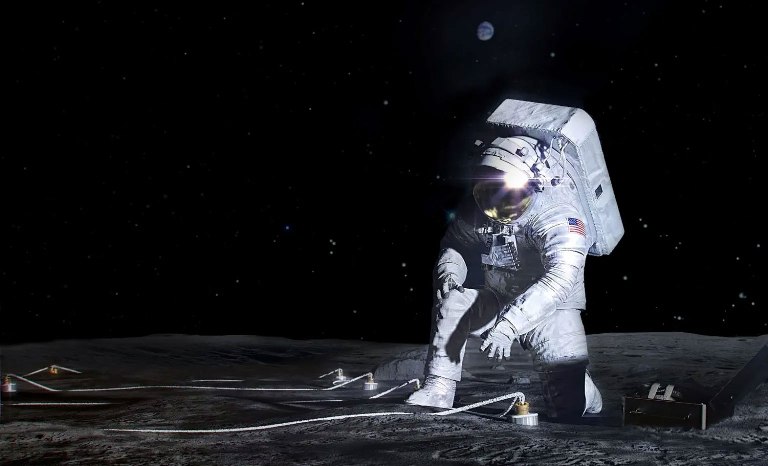
Artist’s concept of Artemis astronaut placing an instrument on the surface of the Moon. NASA
The Lunar Impact on Agricultural Flora (LEAF) program will investigate the effects of the lunar surface environment on space crops. LEAF will be the first experiment to observe photosynthesis, growth, and systemic plant stress responses under cosmic radiation and partial gravity conditions. Data on plant growth and development, as well as environmental parameters measured by LEAF, will help scientists understand the use of plants grown on the Moon, both for human nutrition and to support life on the Moon and beyond. LEAF is led by Christine Escobar of Space Lab Technologies, LLC in Boulder, Colorado.
The Lunar Dielectric Analyzer (LDA) will measure the ability of regolith to propagate an electric field, which is a key parameter in the search for lunar volatiles, especially ice. It will collect important information about the structure of the Moon’s interior, monitor dielectric changes caused by the Sun’s changing angle as the Moon rotates, and look for possible formation of frost or ice deposits. LDA, an internationally contributed payload, is led by Dr. Hideaki Miyamoto from the University of Tokyo and supported by JAXA (Japan Aerospace Exploration Agency).
“These three science instruments will be our first opportunity since Apollo to harness the unique capabilities of human explorers to conduct transformative exploration of the Moon,” said Joel Kerns, deputy associate administrator for exploration at NASA’s Science Mission Directorate in Washington. “These payloads mark our first steps toward implementing the recommendations for high-priority science outlined in the Artemis III Science Definition Panel report.”
Artemis III, the first mission to return astronauts to the lunar surface in more than 50 years, will explore the moon’s south polar region, within 6 degrees latitude of the South Pole. Several of the mission’s proposed landing sites are located among the oldest parts of the Moon. Together with permanently shadowed areas, they provide an opportunity to learn about the history of the Moon through previously unexplored lunar materials.
Through the Artemis Campaign, NASA will land the first woman, the first person of color, and its first international astronaut partner on the Moon, and begin long-term exploration for scientific discovery and preparation for human missions to Mars for the benefit of all.
Astronomy from the Moon
Plans are in the works to place astronomical equipment on the lunar landscape, such as supercooled infrared telescopes, a range of gravitational wave detectors, and large radio telescopes like Arecibo. Some scientists say there is an urgent need to protect any astronomical equipment based on the Moon from interference caused by other planned activities on the Moon, ensuring that it can fulfill its mission of exploring the surrounding universe.
To this end, efforts are ongoing to define the scope and develop policies with the United Nations in hopes of gaining international support for such protection. This action plan is led by the International Astronomical Union (IAU). The IAU brings together more than 12,000 active professional astronomers from more than 100 countries.
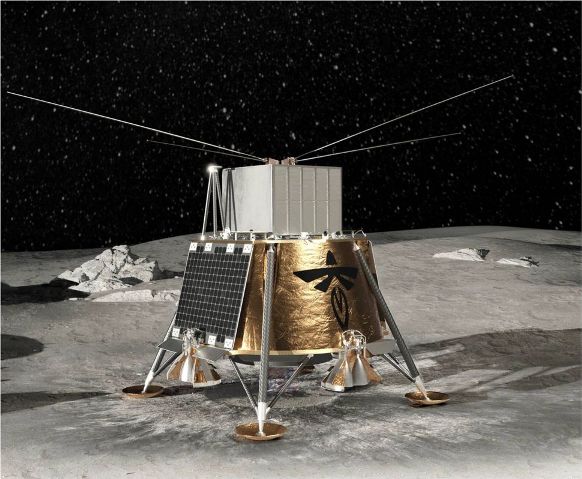
Firefly Aerospace’s Blue Ghost Mission-2 lander will conduct a Lunar Surface Electromagnetic Emission Experiment Night (LuSEE-Night) to explore the “dark ages” of the early universe. Firefly Aerospace
Richard Green is the Chairman of the IAU group dedicated to organizing astronomy from the Moon. He is also the assistant director of government relations at the Steward Observatory, which is operated by the University of Arizona in Tucson.
A number of members of the IAU working group are spectrum managers from radio observatories closely associated with the International Telecommunication Union (ITU) and the ITU World Radiocommunication Conference, a treaty-level forum for reviewing and revising, as necessary, radio regulations and global agreements regarding the use of radio frequency spectrum, geostationary and non-geostationary satellite orbits.
Working group members want to expand the range of protected frequencies as much as possible, “including the very low frequencies needed to study the early Universe and planetary auroras,” Green says.
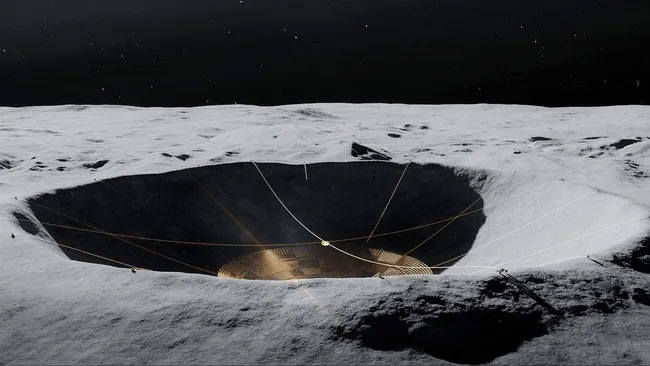
The IAU initiative was endorsed by Ian Crawford, professor of planetary science and astrobiology at Birkbeck College in London.
“My own view is that parts of the lunar site, such as certain polar craters and key locations on the far side, should be designated as ‘Sites of Special Scientific Significance’ and protected as such,” Crawford told.
A possible model, Crawford suggests, would be Antarctic Specially Protected Areas (ASPAs), as defined in Annex V to the Protocol on Environmental Protection to the Antarctic Treaty.
With future robotic exploration of the Moon on the rise with CLPS, we will soon see the first NASA-funded scientific payloads land there in more than 51 years since the Apollo 17 lunar landing in December 1972, says Jack Burns, professor emeritus in the department. in Astrophysical and Planetary Sciences from the University of Colorado, Boulder.
NASA continues testing the Artemis Luna rocket engine
On January 17, NASA continued a series of critical tests for future flights of NASA’s SLS (Space Launch System) rocket in support of the Artemis campaign by conducting a full hot burn of the RS-25 engine at NASA’s Fred Hayes Test Facility at NASA’s Stennis.
Data collected from the series of tests will be used to certify the production of new RS-25 engines by Aerojet Rocketdyne’s lead contractor L3Harris Technologies to power the SLS rocket on future Artemis missions to the Moon and beyond, starting with Artemis V.
Teams are evaluating the performance of several new engine components, including injectors, hydraulic actuators, flexible air ducts and turbopumps. The current series is the second and final series to certify the production of remanufactured engines. In June 2023, NASA completed an initial series of 12 certification tests on the upgraded components.
During the January 17 test, operators followed a “test as if you were flying” approach, running the engine for the same amount of time—almost eight and a half minutes (500 seconds)—required to start the SLS, and at power levels ranging from 80% to 113 %.
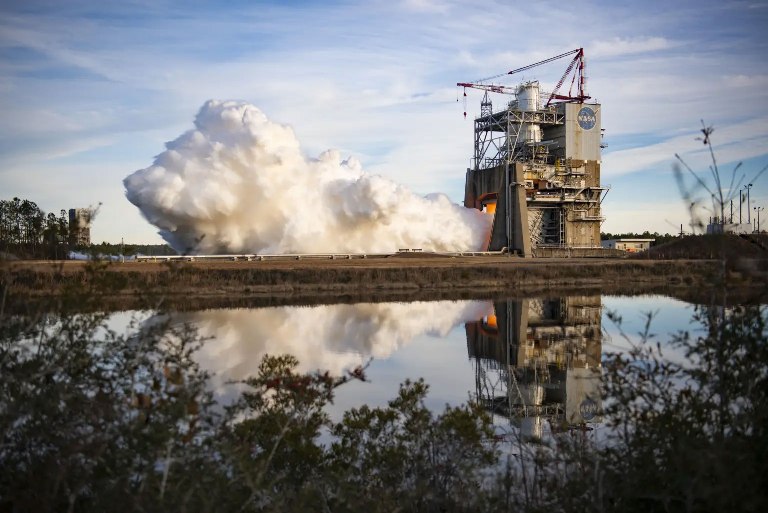
On January 17, NASA completed a full 500-second hot burn of the RS-25 certification engine, continuing a series of critical tests to support future SLS (Space Launch System) missions to the Moon and beyond as NASA explores the secrets of the Universe for the benefit of all. NASA/Danny Nowlin
The January 17 test came three months after the current series began in October. During three tests last fall, operators ran the engine for periods ranging from 500 to 650 seconds. The longest scheduled test in the series occurred on November 29, when crews suspended or controlled the engine for nearly 11 minutes (650 seconds). Gimbal technology is used to control and stabilize the SLS as it enters orbit.
Each SLS flight is powered by four RS-25 engines, which fire simultaneously during launch and climb and produce more than 2 million pounds of thrust.
The first four Artemis missions with SLS use modified space shuttle main engines that can reach 109% of rated power. The new RS-25 engines will develop power up to 111% to provide additional thrust. Testing at 113% power level provides an additional margin of operational safety.
Once the test campaign is completed in 2024, all systems are expected to be ready for production of 24 new RS-25 engines for missions starting with Artemis V.
Through Artemis, NASA will establish a long-term presence on the Moon for scientific exploration with commercial and international partners, learn to live and work away from home, and prepare for future human exploration of Mars.
Roscosmos proposed creating a nuclear energy source on the Moon
Borisov: The Russian Federation can create a nuclear energy source for the lunar base project with the PRC. The creation of a nuclear energy source for the operation of a lunar base could be Russia’s contribution to this joint project with China, said Roscosmos General Director Yuri Borisov.
“It is even more important to create a compact, reliable, long-term and durable source of nuclear energy on the Moon. And this may be one of the serious contributions of the Russian side to the joint Russian-Chinese project,” Borisov said at a lecture for students at the Tsiolkovsky State Museum of the History of Cosmonautics in Kaluga.
He explained that the lunar night lasts approximately 14 Earth days. It is impossible to ensure the operation of electrical appliances for such a long time in the shade only by charging solar panels during the day. Earlier, Borisov said that Roscosmos, together with its Chinese colleagues, is considering the delivery and installation of a nuclear power plant on the surface of the Moon in 2033-2035.
Japanese indestructible SLIM
The pioneering spacecraft, called SLIM (Smart Landing Module for Lunar Exploration), landed on the lunar surface on Friday, January 19, 2024, making Japan the fifth country to join the moon landing club.
But SLIM did not work as planned. Its solar panels were unable to generate electricity on the lunar surface, putting the lander’s future in serious doubt, Japan Aerospace Exploration Agency (JAXA) officials said shortly after the historic landing.
That was about all we knew about the status of SLIM until January 21, when JAXA provided us with another update. And the news was relatively encouraging: the lander had not been declared dead, and its operators were working on a possible recovery.
When SLIM’s battery charge on the lunar surface dropped to 12%, the lander intentionally shut down “to avoid being unable to restart for a recovery operation due to over-discharge,” team members explained early Monday via the mission’s X account.
“According to telemetry data, SLIM’s solar cells are facing west. So if sunlight begins to shine on the lunar surface from the west, there is the possibility of generating electricity and we are preparing for recovery. #SLIM can only operate on solar power,” the team said in a separate post by X. SLIM successfully beamed home technical data and images.
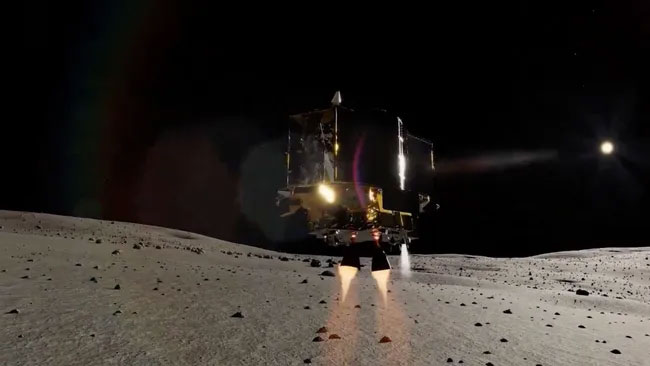
Artist’s illustration of the landing of the Japanese SLIM probe on the Moon. JAXA
SLIM is a demonstrator whose primary mission is to prove the technology needed to land on the Moon with precision, which explains its nickname “Moon Sniper.” The probe intended to land within 330 feet (100 meters) of its designated site on the rim of the lunar crater Scioli.
The probe was launched in September 2023 along with the X-ray space telescope XRISM, which entered low Earth orbit and recently beamed home its first test images.
SLIM reached lunar orbit on Christmas Day and made its historic landing on Friday. JAXA has not yet announced whether the probe has reached its landing target; Presumably we’ll hear more about this in an upcoming update.
SLIM also carried two mini-rovers, named LEV-1 (“Lunar Excursion Vehicle” 1) and LEV-2. Both of these small robots were deployed as planned, and LEV-1 was known to be operating on the lunar surface, JAXA officials said Friday shortly after landing.
The Japan Aerospace Exploration Agency (JAXA) said SLIM endured its third lunar night on Wednesday (April 23) after imaging the lunar surface from the lander.
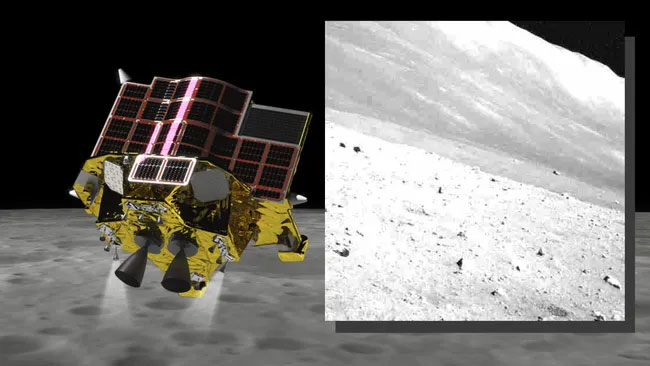
Illustration of the SLIM lunar lander approaching the Moon. An image of the lunar surface taken by the lander on April 23, 2024. JAXA
On their X channel, JAXA shared an image taken by SLIM after their third lunar night on the Moon.
In a translated tweet, the Japanese space agency wrote: “Last night (the night of April 23), we were able to successfully contact #SLIM, which had launched again, and confirmed that SLIM survived for the third time.
The other four countries to have soft-landed a spacecraft on the Moon were the Soviet Union and the United States, both of which first did so during the Cold War space race; China, which first fell into gray mud in 2013; and India, which joined the club in August 2023 with its Chandrayaan-3 mission.
An experiment was carried out on the ISS that will help create materials from lunar soil
The objective of the experiment was, among other things, to provide university students with practical skills in preparing a laboratory workshop on the physical chemistry of dispersed systems, noted Oleg Kononenko, commander of the Roscosmos cosmonaut corps. Roscosmos cosmonaut Nikolai Chub at the International Space Station performed the educational and demonstration space experiment “Dispersion” to study dispersed systems and solutions of polymers of various natures in microgravity conditions, reports TASS special correspondent, commander of the Roscosmos cosmonaut corps Oleg Kononenko.
“Today Nikolay completed the educational and demonstration space experiment “Dispersion”. The main goal of the experiment is to demonstrate the processes of liquid phase separation in polymer-solvent systems and to study the behavior of liquid-phase dispersions under microgravity conditions. In addition, the objective of the experiment is to provide university students with practical skills in preparing a laboratory workshop on the physical chemistry of dispersed systems,” Kononenko said.
It was previously reported that the data obtained will be used to create materials and structural elements in the event of the implementation of the lunar program and development of technological regimes for the production and formation of composite dispersed materials based on lunar soil.
Protection of satellites in Earth-Moon space
As the space around Earth becomes increasingly cluttered with man-made debris, scientists are stepping up their efforts to protect satellites in real time.
The latest in this effort are new algorithms being developed at the University of Central Florida (UCF) to automatically monitor and protect spacecraft from collisions with satellites and asteroids in cislunar space—the realm between the Earth and the Moon that is under the gravitational influence of both celestial bodies.
Because cislunar space is so vast, tracking and predicting the orbits of satellites, spent rocket stages and asteroids is challenging, scientists say.
Current infrastructure “is not equipped to provide the necessary coverage in cislunar space,” Tarek Elgohary, assistant professor of aerospace engineering, said in a UCF statement. “There is a need for fast and accurate solutions to quantify uncertainties to improve forecasts and provide information [space domain awareness] in the absence of consistent coverage.”
“The space and maritime domains have many similarities in terms of the lack of constant coverage of spacecraft or vessels, the large size of the search area and the need to be able to predict maneuvers,” Elgohary said in a statement. “Maritime domain awareness may require shorter time intervals; however, with the expansion of space missions, space awareness operations have been reduced from weeks and days to hours and minutes.”
The number of satellites orbiting our planet increased by nearly 3,000 last year—a 15% increase over 2022, according to a report from Slingshot Aerospace published in April. Of the more than 12,500 satellites in orbit, 3,000 are inactive and “taking up valuable space,” Melissa Quinn, general manager of Slingshot, said in a press release.
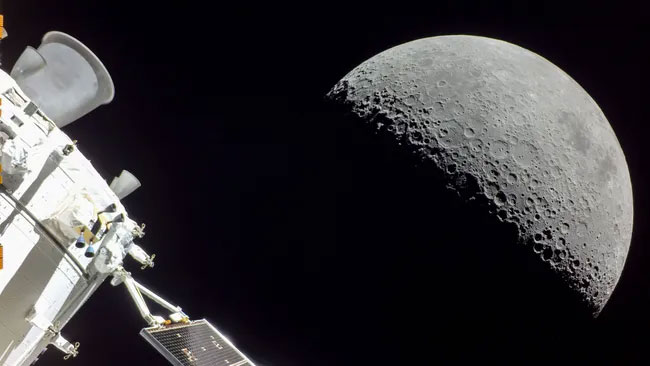
The Moon as seen from the Artemis 1 Orion capsule on December 5, 2022, near the end of the mission. NASA
Although the vast majority of these inactive satellites were placed into “graveyard orbits” at the end of their service life, the average distance between satellites in orbit fell last year due to a sharp increase in the number of satellite launches, and this trend is expected to continue as new space devices.
Experts have been sounding the alarm for years about the harmful effects of growing amounts of space debris. For example, last October, researchers analyzing applications to the International Telecommunication Union (ITU), the UN agency responsible for providing orbital space for satellite use, found that more than 1 million satellites had been proposed for LEO.
“If even a fraction of these millions of satellites are actually launched, national and international regulations will be needed to address associated sustainability issues such as collision risks, light pollution and atmospheric re-entry risks,” Andrew Falle, a researcher at External University British Columbia.
And this month, a NASA report concluded that reducing the time it takes to decommission a failed spacecraft to less than five years is one of the most cost-effective ways to reduce the amount of debris in Earth orbit. The report was based on modeling the evolution of space debris over 30 years and the financial costs incurred by satellite operators due to maneuvers aimed at avoiding mission-terminating collisions with other satellites or debris. It also found that timely collision avoidance, which moves debris out of the collision path and removing centimeter-sized debris from orbit, “can provide benefits that are 300 and 100 times the costs, respectively.”
Safety comes first on Artemis moon missions despite ‘space race’ with China, NASA chief says
Artemis 2 is expected to fly in 2025, with the safety of astronauts taking priority over schedule. NASA Administrator Bill Nelson, mindful of what he calls the “space race” with China to establish a sustainable presence on the Moon, announced on May 23, 2024, that he would commit to Artemis 2’s current launch date of September 2025 only if the safety of the astronauts is ensured.
The Artemis 2 lunar orbit along with the Artemis 3 lunar landing was delayed in January of this year due in part to the long-known unexpected erosion of the Orion spacecraft’s heat shield during re-entry into the Earth’s atmosphere during the Artemis test mission. 1 without a crew will take place in December 2021. Artemis 2’s schedule has been cut by nine months, and Artemis 3 has been delayed by at least a year until 2026.

NASA Administrator Bill Nelson testifies before the Senate Subcommittee on Commerce, Justice, Science and Related Agencies during a fiscal year 2025 budget hearing Thursday, May 23, 2024, at the Dirksen Senate Office Building in Washington. NASA
Nelson was speaking before the Senate Appropriations Committee, which oversees NASA, as part of 2025 budget negotiations that will last several months. But Nelson’s testimony came weeks after NASA’s Office of Inspector General (OIG) released a report saying ablation problems pose “significant risks” to the safety of Artemis 2.
Of course, the heat shield isn’t the only reason for the Artemis program’s delays; commercial spacesuits, as well as the SpaceX Starship lander needed for Artemis 3, also face development challenges. Starship has yet to complete a full uncrewed orbital test mission, including safe reentry, for example, although SpaceX could try again as early as next month. (NASA has repeatedly stated that it wants several successful Starship flights and specific goals to be achieved before allowing astronauts to fly on board.)
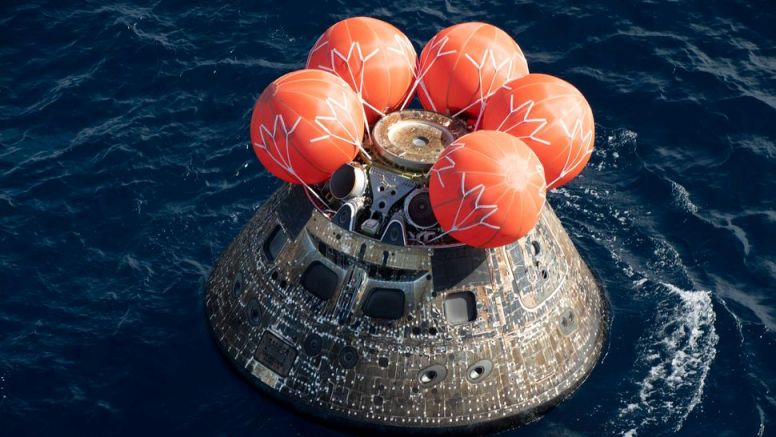
NASA’s Orion spacecraft for the Artemis 1 mission after splashdown in the Pacific Ocean on December 11, 2022. NASA
Geopolitical tensions, Nelson acknowledged, are one reason NASA is trying to get to the Moon safely but quickly: China is reportedly planning to land astronauts on the Moon’s supposedly water-rich south pole by 2030, Reuters reports.
Meanwhile, NASA is planning an unmanned landing there as early as this year as part of its Commercial Lunar Payload Services program, which commissions companies to send NASA scientific payloads to the Moon.
“We have a probe on a commercial lander that will launch later this year that will dig and test to see if there is water at the south pole,” Nelson said, referring to the 1 Astrobotic Technology Griffin mission that will carry NASA’s Volatiles Investigating Polar Exploration Rover or VIPER mission.
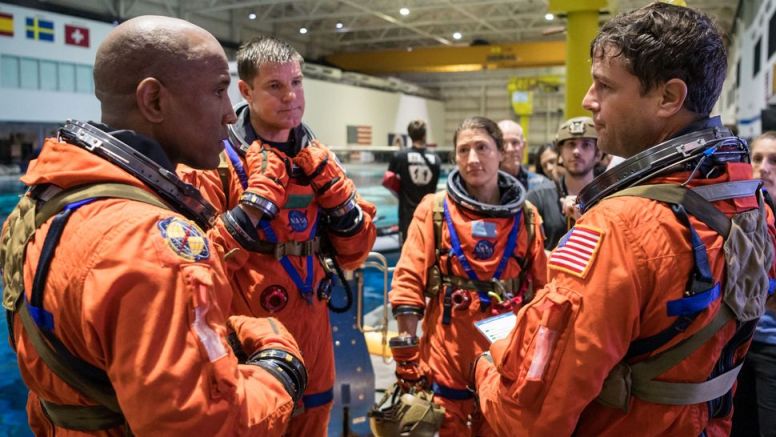
The Artemis 2 lunar crew during splashdown training at NASA’s Neutral Buoyancy Laboratory in Houston. NASA
“If there is water, then there is rocket fuel, hydrogen and oxygen – and this becomes a very valuable resource. That’s why China is also heading to the South Pole.”
China is a recurring topic in congressional meetings involving NASA; the agency cannot enter into bilateral agreements or coordinate with the country under a 2011 directive known as the Wolf Amendment unless Congress grants authorization.
For example, earlier this year, several members of the US House Subcommittee on Space and Aeronautics said China’s Tiangong space station would be at an advantage for lucrative low-Earth orbit exploration if there was a gap between the expected closure of the International Space Station in 2030 and the emergence of private space stations in the next decade.




